Spring arrives with vibrant colors and flavors that excite our taste buds and spirits. It’s a time to reconnect with the earth and enjoy its fresh ingredients. Imagine biting into a sun-kissed tomato or savoring fresh peas, all full of nutrients for a healthier lifestyle.
In this collection of 20 vegetable-based recipes, you’ll learn to use the season’s best in your kitchen. These healthy vegetarian dishes celebrate nature’s gifts and bring joy and creativity to your meals. They’re quick to make, ready in 35 to 45 minutes, perfect for any day.
Join us in exploring these delightful dishes. They promise to make your cooking more enjoyable while keeping your palate and health in mind.
Key Takeaways
- Spring is the season for fresh, seasonal vegetables that add flavor and nutrients to meals.
- The 20 vegetable-based recipes are ideal for quick, healthy dining with average prep times of around 35 to 45 minutes.
- Incorporating a variety of cooking techniques can enhance the natural tastes of vegetables.
- These recipes focus on balance, featuring proteins and grains for well-rounded vegetarian dishes.
- Bright and tangy dressings will elevate your spring salads, creating an appealing culinary experience.
Spring Vegetable Highlights
Spring is a vibrant time for food lovers, with fresh, seasonal produce in abundance. Eating seasonal produce boosts flavor, nutrition, and supports local farmers. Adding spring vegetables to your meals can make them taste better and be healthier.
Benefits of seasonal produce
Seasonal foods like asparagus, peas, and strawberries are packed with nutrients. They taste better and are more nutritious when they’re in season. This choice also helps the environment by reducing waste and pollution3. Plus, it makes healthy eating fun and flavorful.
Common spring vegetables to incorporate
Spring favorites include asparagus, spinach, radishes, and peas. Asparagus is perfect for salads and stir-fries. Spinach adds flavor and nutrition to dishes like Spanakopita, needing about 2.5 pounds. Radishes add a peppery kick to salads, mixing sweet and savory. Using these veggies in your cooking can lead to exciting, new recipes.
20 Vegetable Based Recipes
Spring brings a lot of fresh produce, perfect for trying out vegetable-based recipes. These 20 recipes showcase the season’s flavors, offering nutritious and tasty meals. You can make meals exciting with salads, easy vegan dishes, and colorful stir-fries.
Salads featuring seasonal greens
Start with salads that highlight seasonal greens like spinach and arugula. Try a Kale & Quinoa Salad with Lemon Dressing for a refreshing choice. This salad is ready in 20 minutes, mixing greens with quinoa for a healthy meal.
Easy vegan dishes for quick meals
For quick weeknights, vegan dishes are a great option. The Vegan Curry with spinach and sweet potatoes is under 400 calories and full of nutrients. Most recipes are ready in 30 minutes or less, fitting a fast lifestyle.
Colorful vegetable stir-fries
Colorful stir-fries are a great way to eat lots of veggies. A quick stir-fry, made in about 30 minutes, lets you mix and match seasonal veggies for a flavorful dish. Adding tofu or chickpeas boosts the protein, making it a quick and satisfying meal.
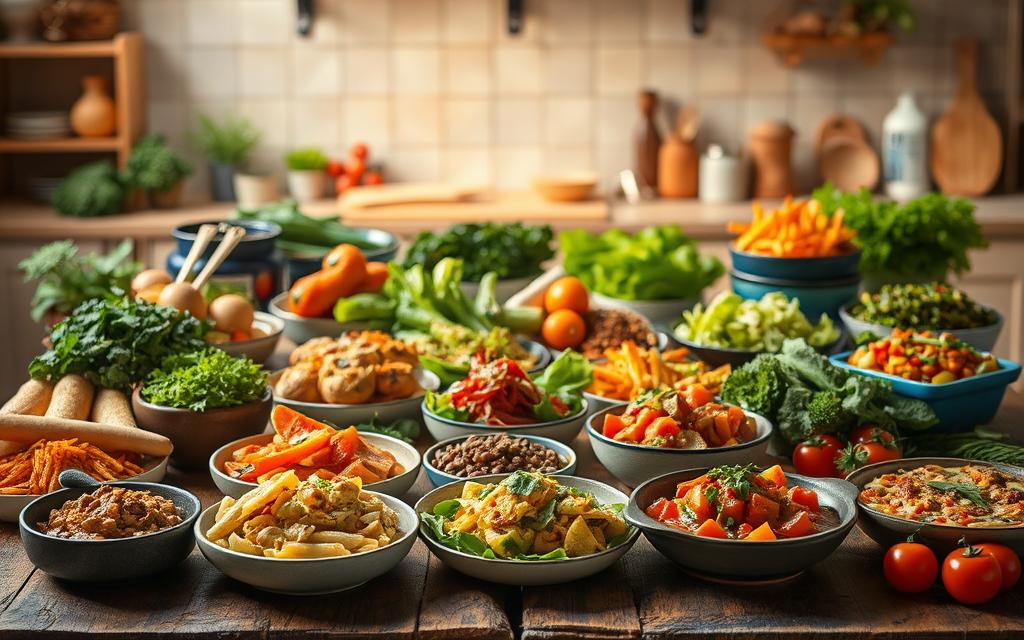
Healthy Cooking Techniques
Choosing the right cooking methods is key to keeping vegetables nutritious and tasty. Steaming and grilling are top choices because they bring out the best in fresh produce. Steaming is gentle, keeping up to 90% of nutrients, unlike boiling which can lose a lot. This makes steaming great for keeping the health benefits of seasonal veggies.
Steaming vs. sautéing vegetables
Steaming is great for keeping nutrients, but sautéing has its own perks. It makes food taste better by caramelizing it, adding a rich flavor. About 75% of quick meals use sautéing, showing it’s quick and tasty. Mixing these methods can make veggies vibrant and full of nutrients, making them both tasty and healthy.
Grilling for enhanced flavor
Grilling veggies gives them a smoky taste that’s hard to beat. It’s perfect for spring veggies like asparagus and bell peppers, turning simple dishes into gourmet ones. The high heat makes the outside smoky and the inside tender, boosting any meal’s flavor. Grilling makes veggies not only taste better but also look great and stay nutritious, making it a must in healthy cooking.

Nutritious Vegetarian Dishes
Nutrition is key to staying healthy. Legumes like chickpeas, lentils, and black beans add protein to meals. They also make dishes more filling and tasty.
There are many recipes that use beans or legumes. You can find everything from black bean burgers to lentil soups. These dishes are great for a balanced diet and are loved by many.
Using legumes for added protein
Legumes can make vegetarian meals much more protein-rich. A big vegetarian chili can serve six and is great for freezing. It’s perfect for meal prep.
Adding beans to salads or grain bowls makes them more filling. A Mediterranean quinoa bowl is a healthy, colorful choice. It’s packed with quinoa, a top plant-based protein.
Incorporating grains into vegetable meals
Whole grains are crucial for balanced, nutritious meals. Adding grains like quinoa, brown rice, and farro to veggie dishes adds flavor and texture. They also boost nutritional value.
A vegetarian grain bowl with farro, sweet potatoes, fennel, and spinach is perfect for four. It’s a nutritious meal that’s easy to make and serves the whole family. Using grains in vegetarian cooking is becoming more popular. It meets the demand for healthy, tasty meals.

Organic Recipe Ideas
Using organic vegetables in your cooking makes your meals taste better and are healthier. Organic produce is not only delicious but also good for you. It also helps the environment because organic farming is better for nature.
By shopping at local organic markets, you help your community and get fresher ingredients. These ingredients make your organic vegetable recipes even better.
Importance of organic vegetables
Organic veggies are grown without harmful chemicals. This means they keep more nutrients and are safer to eat. They also help the environment and are better for your health.
Cooking with organic veggies makes your meals tasty and good for you. Chefs say organic veggies taste better, making meals more enjoyable. Using organic produce lets you enjoy the best of what’s in season from local markets.
Where to find local organic markets
Finding local organic markets is a great way to get fresh ingredients and support local farmers. These markets have a wide range of seasonal veggies for your recipes. Many places have farmer’s markets or co-ops where you can buy directly from the farmers.
Look for local listings or community boards to find when and where these markets are. Going to these markets helps you appreciate food more and connect with the people who grow it.
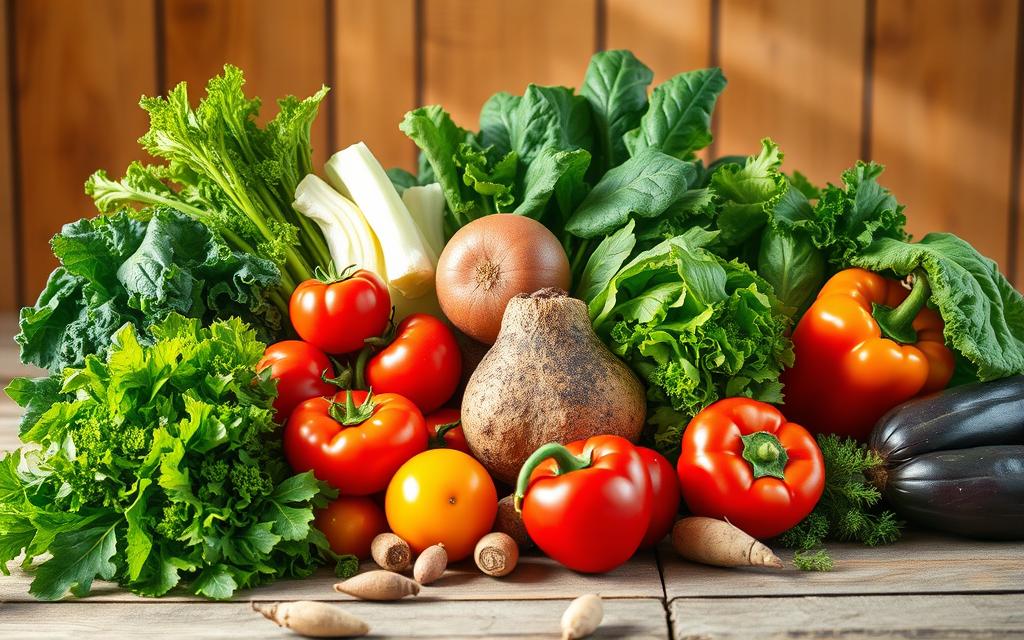
Delicious Vegetable Cuisine
Starting your cooking journey with vegetable dishes is exciting. Making flavorful sauces for veggies can really bring out their taste. Simple dressings can make a big difference, turning a meal into something special.
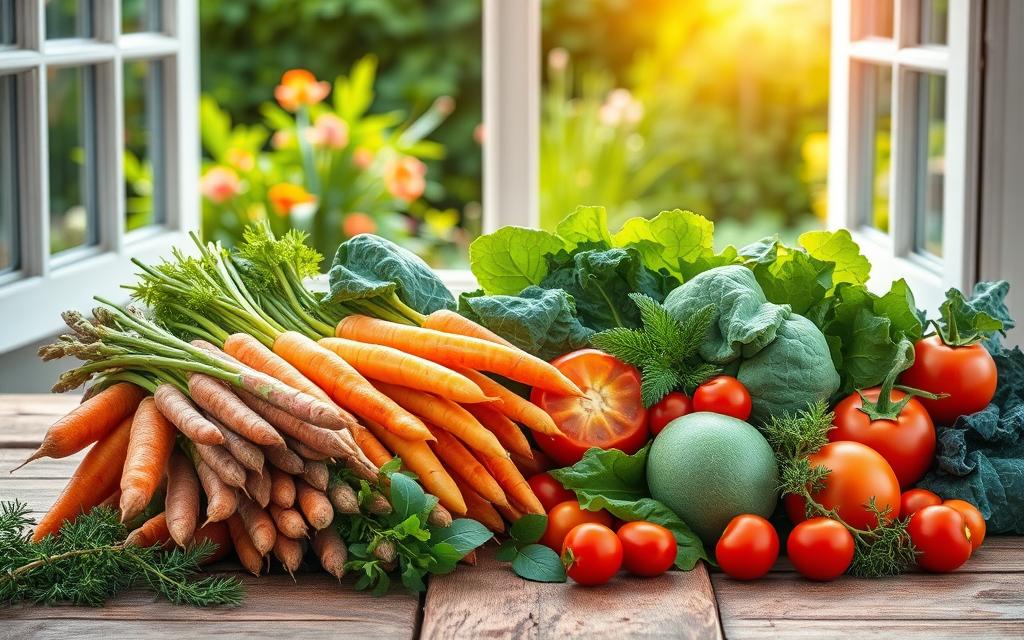
Creating flavorful sauces for veggies
Homemade sauces are key to making veggies shine. You can make tahini dressings or herb-infused oils to match the season. For instance, roasted broccoli with pickled pepper vinaigrette adds a zesty kick.
Using maple syrup and ginger in sweet potato recipes is a creative twist13.
Pairing vegetables with complementary herbs
Choosing the right herbs can take your vegetable dishes to the next level. For example, Swiss chard with Gruyère cheese makes a tasty gratin. Herbs like basil, dill, and cilantro pair well with artichokes and asparagus in spring.
By trying out different herb combinations, you can make your dishes unique and explore new flavors.
Plant-Based Recipe Collection
This spring, dive into a world of plant-based recipes. They’re perfect for the season, with a focus on fresh veggies and easy prep. These dishes bring vibrant flavors and healthy ingredients, great for anyone wanting to eat better.
Top 5 recipes to try this spring
- Spring Vegetable Stir-Fry: A colorful mix of veggies in a light sauce, ideal for fast meals.
- Lentil Bowls: Lentils, fresh greens, and roasted veggies make a protein-rich dish. Each bowl feeds 7 and is ready in under 30 minutes.
- Chilled Asparagus Salad: Asparagus and a tangy dressing make a light, easy salad to prep ahead.
- Quinoa Stuffed Peppers: Bell peppers filled with quinoa and beans serve 7 and can be frozen for later.
- Vegetable Broth: A low-calorie base for many dishes, with just 15 calories per serving.
Meal prepping with vegetables
Meal prepping with these recipes makes your week easier. They offer about 30 grams of carbs per serving, keeping you energized and meals fun and healthy. Most can be stored in the fridge for up to four days, so you can grab healthy meals anytime. These plant-based recipes ensure tasty, nutritious meals without the rush of last-minute cooking.
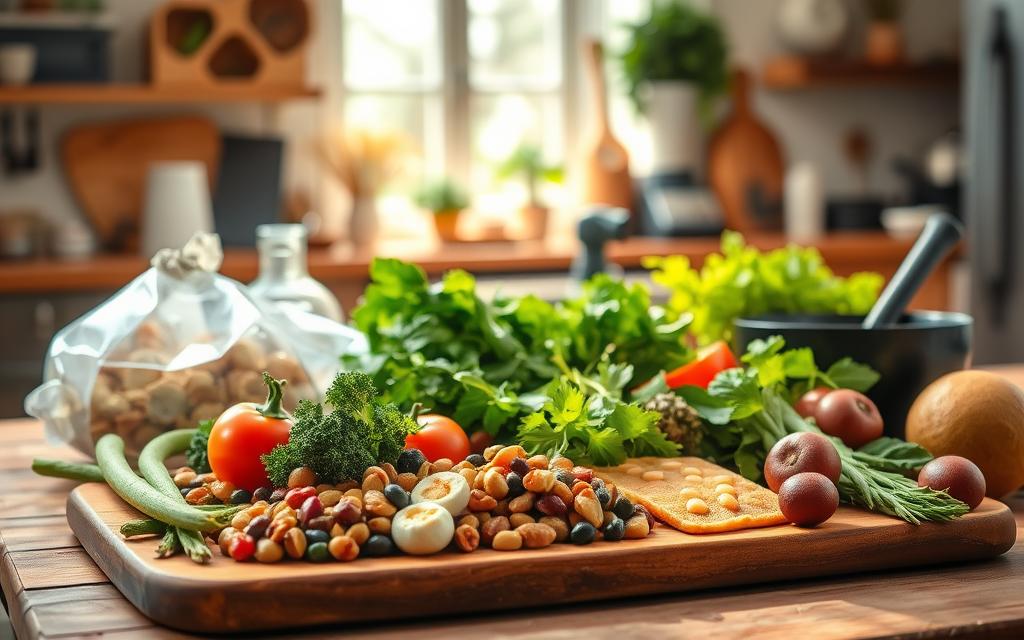
Vegetarian Cooking Inspiration
Exploring vegetarian cooking can lead to exciting meals. Using leftovers in new ways is a great idea. For example, you can turn last night’s roasted veggies into a tasty salad or a warm soup. This approach not only reduces waste but also boosts flavor, making your meals both healthy and vibrant.
Creative uses for leftovers
Leftovers are a chance to get creative in the kitchen. Try making a veggie-packed quesadilla with different veggies and cheese. This quick dish can be ready in just a few minutes. Recipes that take 20 minutes or less are perfect for busy weeknights. You can also use leftover roasted veggies in wraps, with hummus and greens.
Elevating basic recipes with toppings
Adding the right toppings can elevate simple dishes. A sprinkle of fresh herbs or a drizzle of olive oil can make a big difference. Consider adding toasted nuts, seeds, or sharp cheese to your salads for extra texture and taste. Toppings like panko and Parmigiano-Reggiano can add a nice crunch to baked veggies. Trying out these toppings can turn a basic meal into a gourmet delight.
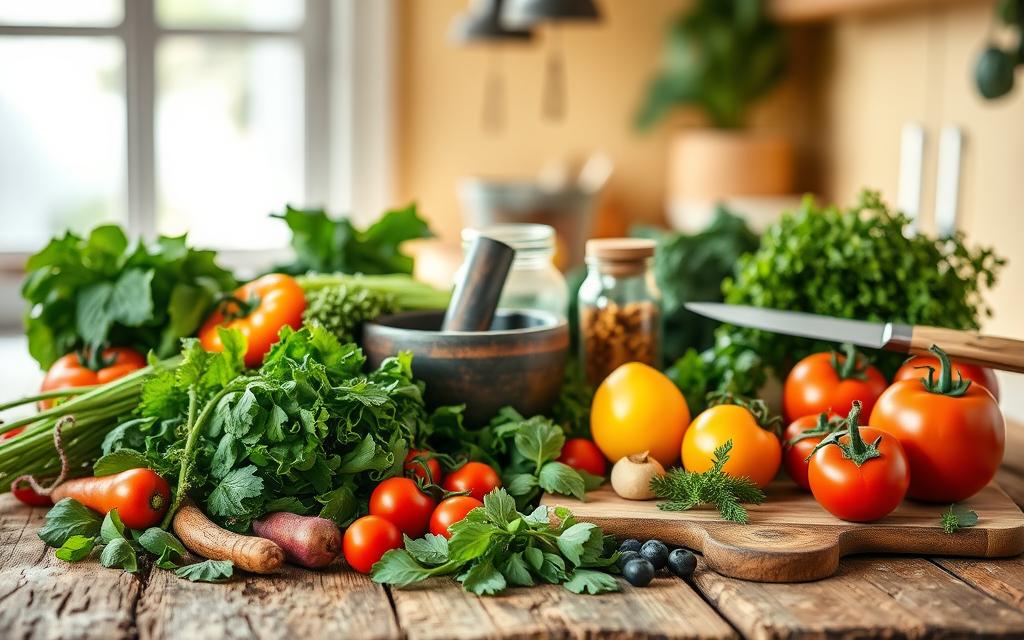
| Leftover Item | Creative Idea | Preparation Time |
|---|---|---|
| Roasted Vegetables | Vegetable Soup | 10 minutes |
| Cooked Quinoa | Quinoa Salad | 15 minutes |
| Vegetable Stir-Fry | Veggie Wraps | 10 minutes |
| Cooked Pasta | Pasta Bake | 20 minutes |
| Mashed Potatoes | Potato Pancakes | 15 minutes |
Easy Veggie Meal Ideas
When time is tight, easy veggie meals are a big help. One-pot meals are simple and quick, perfect for those with little time. They can be made in about 30 minutes, ideal for busy weeknights.
Using pantry staples like lentils and broth saves time and money. These ingredients help make meals full of plant-based proteins and whole grains.
One-pot veggie meals for busy nights
One-pot meals use fresh veggies like corn, eggplant, and tomatoes. They offer great taste and nutrition. With a little seasoning, these meals can be incredibly tasty.
These dishes are about 450 calories and 10 grams of fiber per serving. They’re quick to make, ready in 20 to 30 minutes.
Wraps and sandwiches using fresh ingredients
Fresh ingredient wraps are great for lunch or dinner. They’re easy to make and can please many tastes. You can use leafy greens and legumes for protein.
These meals can be frozen for up to three months. This makes them perfect for meal prep, keeping healthy meals ready all week.
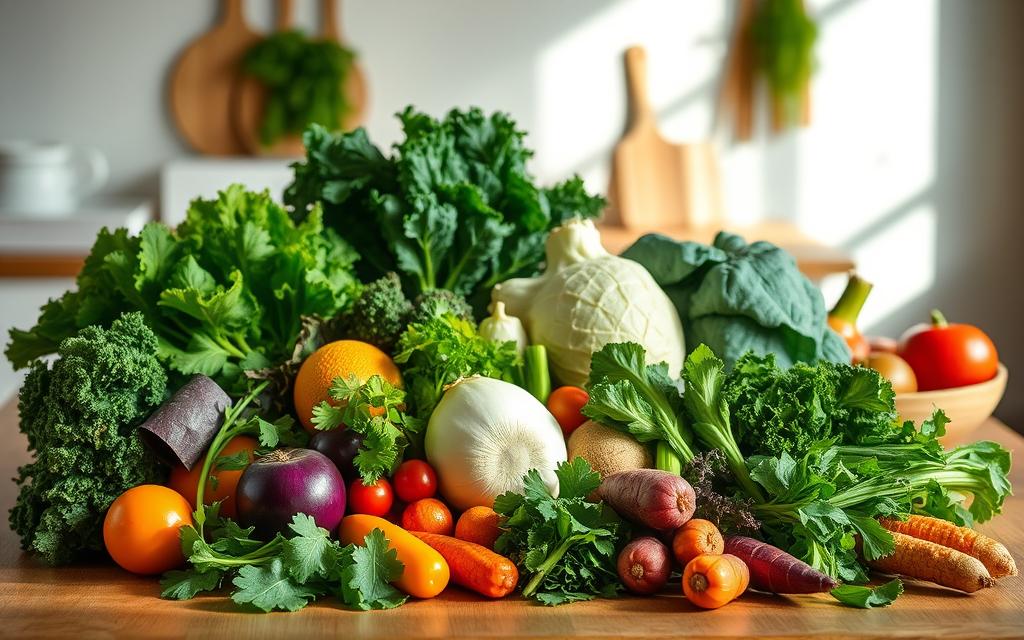
Seasonal Produce Recipes
Spring brings fresh produce like asparagus and snap peas. These add color and nutrition to your meals. They’re perfect for the warmer days ahead.
Highlighting asparagus and snap peas
Asparagus is great in many recipes. Roasting or grilling it brings out its taste. Snap peas add a crunchy texture to salads or stir-fries.
For roasting, use an oven at 400 to 450 degrees Fahrenheit. This ensures the best flavor and tenderness. A roasted vegetable mix with asparagus and snap peas is a great side dish. It’s healthy and delicious.
Refreshing salads for warmer days
Salads are perfect for warm weather, especially with seasonal ingredients. Try a salad with asparagus, snap peas, and quinoa for a nutritious meal. It’s easy to make and serves six people quickly.
A vibrant green salad is ready in 20 minutes. It shows that healthy meals don’t take long to prepare. As the season changes, these salads let you get creative with flavors.
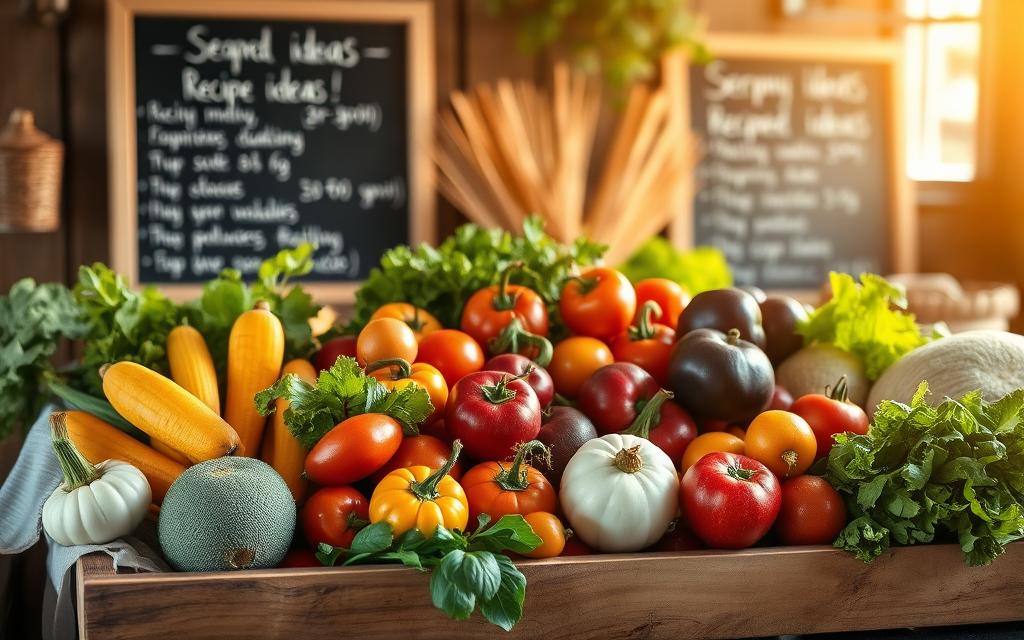
Quick and Simple Vegetable Recipes
Preparing quick vegetable recipes can be a game-changer for those with tight schedules. This section focuses on 30-minute meals that are healthy and easy to make. These recipes use minimal ingredients, making them quick and enjoyable to prepare.
30-minute meals for a busy lifestyle
It’s crucial to make meals in 30 minutes or less to keep a balanced diet. Many quick vegetable recipes are ready in about 20 minutes, perfect for last-minute dinners. Using frozen or canned veggies can save a lot of time since they don’t need peeling or chopping.
Sautéed veggies can be cooked in under 10 minutes, making it a fast cooking method.
Minimal ingredient recipes for convenience
Recipes with few ingredients make meal planning and cooking easier. For example, Brussels sprouts with just three ingredients or Hasselback potatoes with only two main components are quick and delicious. Using seasonal veggies like zucchini and sweet potatoes adds flavor and variety to meals.
A Greek salad that doesn’t need cooking shows how a few ingredients can make a great dish.
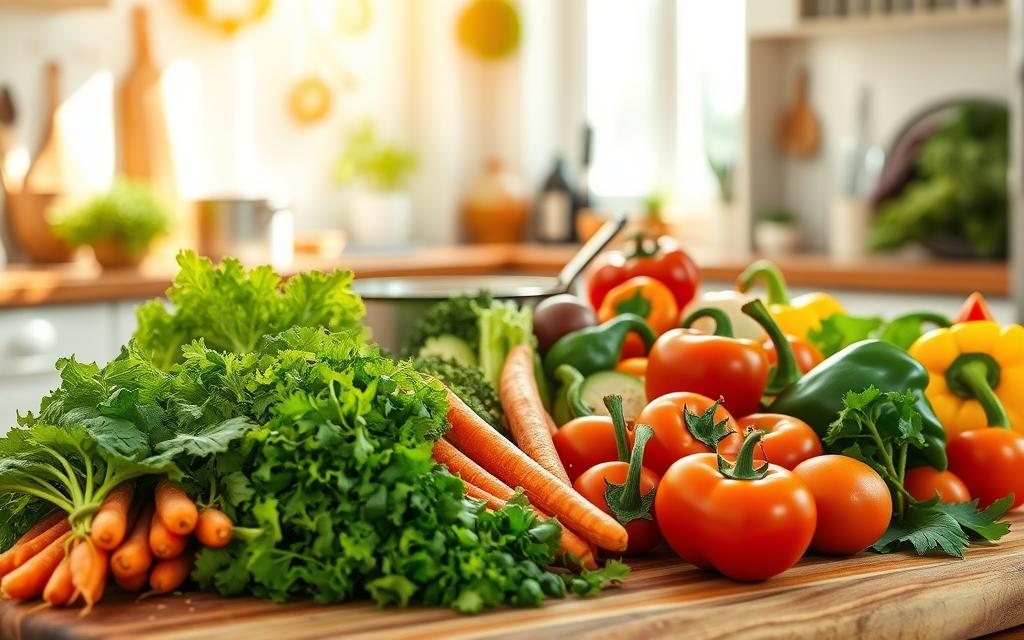
Fresh and Light Spring Dishes
Spring is the best time to enjoy fresh fruits and veggies. Mixing fruits with veggies makes flavors pop and adds a sweet touch. Recipes for this season often feature asparagus, peas, and baby potatoes. Yogurt or vinegar dressings keep salads light, letting the natural flavors stand out.
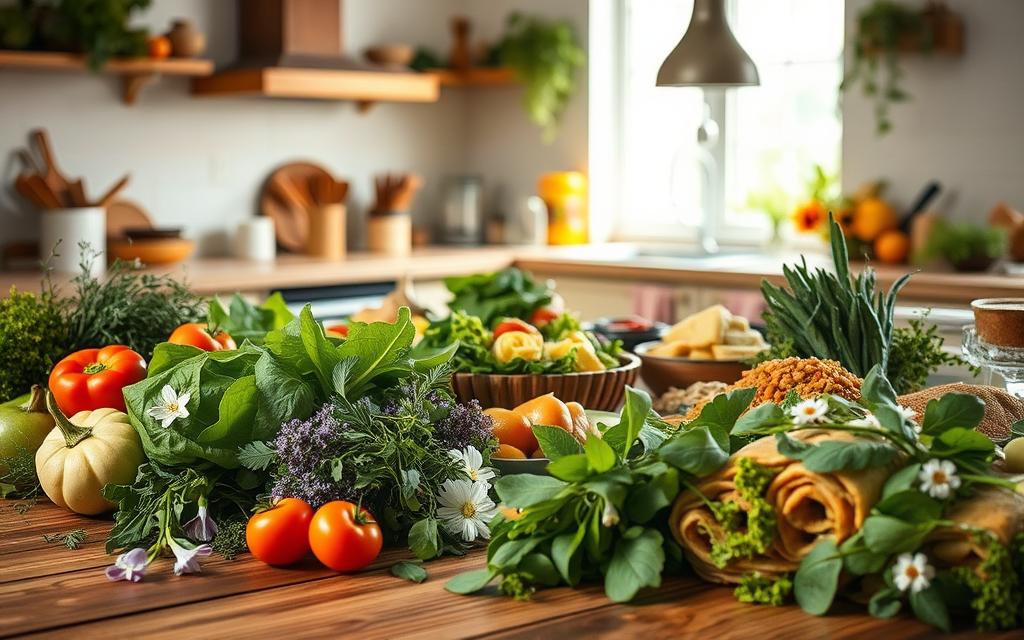
Incorporating fruit with vegetables
Fruits can add a fun twist to veggie dishes. Adding citrus, strawberries, or apples to salads can make them better. Many recipes pair fruits with greens or roasted veggies, making plates colorful and healthy.
Light dressings to enhance salads
Light salad dressings are key to great spring dishes. Simple ingredients like olive oil, vinegar, and herbs make tasty, low-calorie dressings. Herbs like dill, chives, or mint can make dishes brighter and more refreshing. Quick recipes with light dressings can turn simple ingredients into a vibrant meal in under an hour.
Conclusion
As we finish our look at 20 vegetable-based recipes for spring, it’s key to see their benefits. These healthy dishes can boost our health and help the planet. Using seasonal produce makes our food taste better and supports local farmers.
Adding these recipes to your meals can bring people together. Share your cooking with friends and family. This way, you celebrate health, creativity, and nature’s gifts. Vegetables offer endless options for tasty meals, making life more enjoyable and nutritious.
Start exploring this collection and let each recipe guide you to make tasty, healthy meals. Every plant-based choice you make is a step towards better health and a greener world.
FAQ
What are the benefits of using seasonal produce in my meals?
Seasonal produce tastes better, is more nutritious, and supports local farmers. It also reduces environmental harm by cutting down on transportation. This way, you get to enjoy food that’s fresher and more flavorful.
What are some common spring vegetables to include in my diet?
Spring veggies like asparagus, spinach, and radishes are great. They add crunch and color to your meals. Adding them can make your food taste better and be healthier.
How can I prepare quick and healthy veggie meals?
For fast, healthy meals, try one-pot recipes or easy vegan dishes. Colorful stir-fries are also quick and delicious. Using seasonal ingredients makes these meals tasty and good for you.
What healthy cooking techniques should I use for vegetables?
Steaming helps keep veggies’ nutrients and color. Sautéing adds flavor with caramelization. Grilling brings out the best in asparagus and bell peppers.
Why should I add legumes to my vegetable dishes?
Legumes like chickpeas and lentils add protein and texture. They make your meals more filling and satisfying. This helps you stick to a plant-based diet.
How do organic vegetables improve my recipes?
Organic veggies taste better and support sustainable farming. They’re often more nutritious and help local economies. You can find them in local organic markets.
What are some easy ways to elevate vegetable dishes?
To improve flavors, make homemade sauces and use herbs. Add nuts, seeds, and cheeses for texture and taste. These touches can make your meals more exciting.
What are some meal prep ideas using spring vegetables?
Prep meals with seasonal veggies like salads, stir-fries, or one-pots. This way, you have healthy, quick options ready for busy days.
How can I creatively use leftovers from vegetable dishes?
Turn leftovers into soups or casseroles or add fresh toppings. This reduces waste and lets you get creative in the kitchen.
What are some light and refreshing options for spring?
Adding fruits to veggies and using light dressings can enhance flavors. These options celebrate fresh produce while keeping your meals light and healthy.
